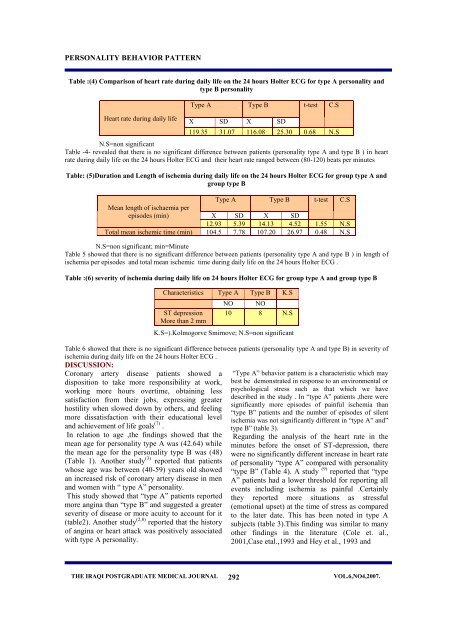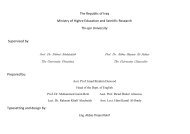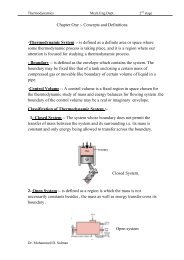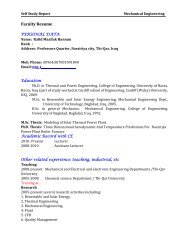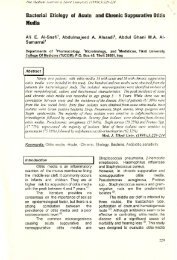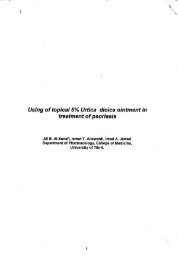The Effect of Personality Behavior Pattern ,Type A and ... - iasj.net
The Effect of Personality Behavior Pattern ,Type A and ... - iasj.net
The Effect of Personality Behavior Pattern ,Type A and ... - iasj.net
Create successful ePaper yourself
Turn your PDF publications into a flip-book with our unique Google optimized e-Paper software.
PERSONALITY BEHAVIOR PATTERN<br />
Table :(4) Comparison <strong>of</strong> heart rate during daily life on the 24 hours Holter ECG for type A personality <strong>and</strong><br />
type B personality<br />
Heart rate during daily life<br />
N.S=non significant<br />
Table -4- revealed that there is no significant difference between patients (personality type A <strong>and</strong> type B ) in heart<br />
rate during daily life on the 24 hours Holter ECG <strong>and</strong> their heart rate ranged between (80-120) beats per minutes<br />
Table: (5)Duration <strong>and</strong> Length <strong>of</strong> ischemia during daily life on the 24 hours Holter ECG for group type A <strong>and</strong><br />
group type B<br />
Mean length <strong>of</strong> ischaemia per<br />
episodes (min)<br />
N.S=non significant; min=Minute<br />
Table 5 showed that there is no significant difference between patients (personality type A <strong>and</strong> type B ) in length <strong>of</strong><br />
ischemia per episodes <strong>and</strong> total mean ischemic time during daily life on the 24 hours Holter ECG .<br />
Table :(6) severity <strong>of</strong> ischemia during daily life on 24 hours Holter ECG for group type A <strong>and</strong> group type B<br />
K.S=).Kolmogorve Smirnove; N.S=non significant<br />
Table 6 showed that there is no significant difference between patients (personality type A <strong>and</strong> type B) in severity <strong>of</strong><br />
ischemia during daily life on the 24 hours Holter ECG .<br />
DISCUSSION:<br />
Coronary artery disease patients showed a<br />
disposition to take more responsibility at work,<br />
working more hours overtime, obtaining less<br />
satisfaction from their jobs, expressing greater<br />
hostility when slowed down by others, <strong>and</strong> feeling<br />
more dissatisfaction with their educational level<br />
<strong>and</strong> achievement <strong>of</strong> life goals (7) .<br />
In relation to age ,the findings showed that the<br />
mean age for personality type A was (42.64) while<br />
the mean age for the personality type B was (48)<br />
(Table 1). Another study (3) reported that patients<br />
whose age was between (40-59) years old showed<br />
an increased risk <strong>of</strong> coronary artery disease in men<br />
<strong>and</strong> women with “ type A” personality.<br />
This study showed that “type A” patients reported<br />
more angina than “type B” <strong>and</strong> suggested a greater<br />
severity <strong>of</strong> disease or more acuity to account for it<br />
(table2). Another study (2,8) reported that the history<br />
<strong>of</strong> angina or heart attack was positively associated<br />
with type A personality.<br />
<strong>Type</strong> A <strong>Type</strong> B t-test C.S<br />
X SD X SD<br />
119.35 31.07 116.08 25.30 0.68 N.S<br />
<strong>Type</strong> A <strong>Type</strong> B t-test C.S<br />
X SD X SD<br />
12.93 5.39 14.13 4.52 1.55 N.S<br />
Total mean ischemic time (min) 104.5 7.78 107.20 26.97 0.48 N.S<br />
Characteristics <strong>Type</strong> A <strong>Type</strong> B K.S<br />
ST depression<br />
More than 2 mm<br />
NO NO<br />
10 8 N.S<br />
“<strong>Type</strong> A” behavior pattern is a characteristic which may<br />
best be demonstrated in response to an environmental or<br />
psychological stress such as that which we have<br />
described in the study . In “type A” patients ,there were<br />
significantly more episodes <strong>of</strong> painful ischemia than<br />
“type B” patients <strong>and</strong> the number <strong>of</strong> episodes <strong>of</strong> silent<br />
ischemia was not significantly different in “type A” <strong>and</strong>”<br />
type B” (table 3).<br />
Regarding the analysis <strong>of</strong> the heart rate in the<br />
minutes before the onset <strong>of</strong> ST-depression, there<br />
were no significantly different increase in heart rate<br />
<strong>of</strong> personality “type A” compared with personality<br />
“type B” (Table 4). A study (9) reported that “type<br />
A” patients had a lower threshold for reporting all<br />
events including ischemia as painful .Certainly<br />
they reported more situations as stressful<br />
(emotional upset) at the time <strong>of</strong> stress as compared<br />
to the later date. This has been noted in type A<br />
subjects (table 3).This finding was similar to many<br />
other findings in the literature (Cole et. al.,<br />
2001,Case etal.,1993 <strong>and</strong> Hey et al., 1993 <strong>and</strong><br />
THE IRAQI POSTGRADUATE MEDICAL JOURNAL 292<br />
VOL.6,NO4,2007.


